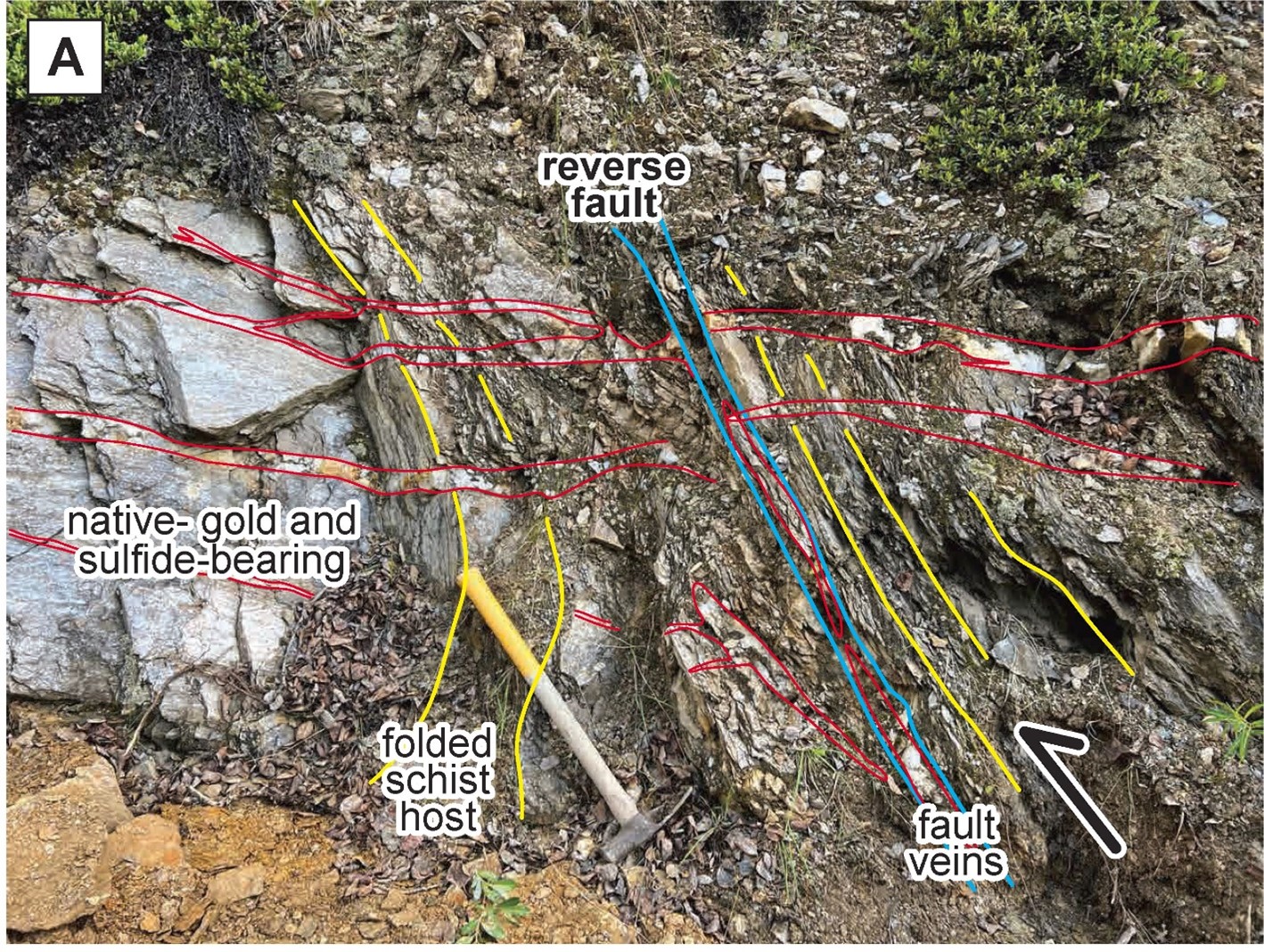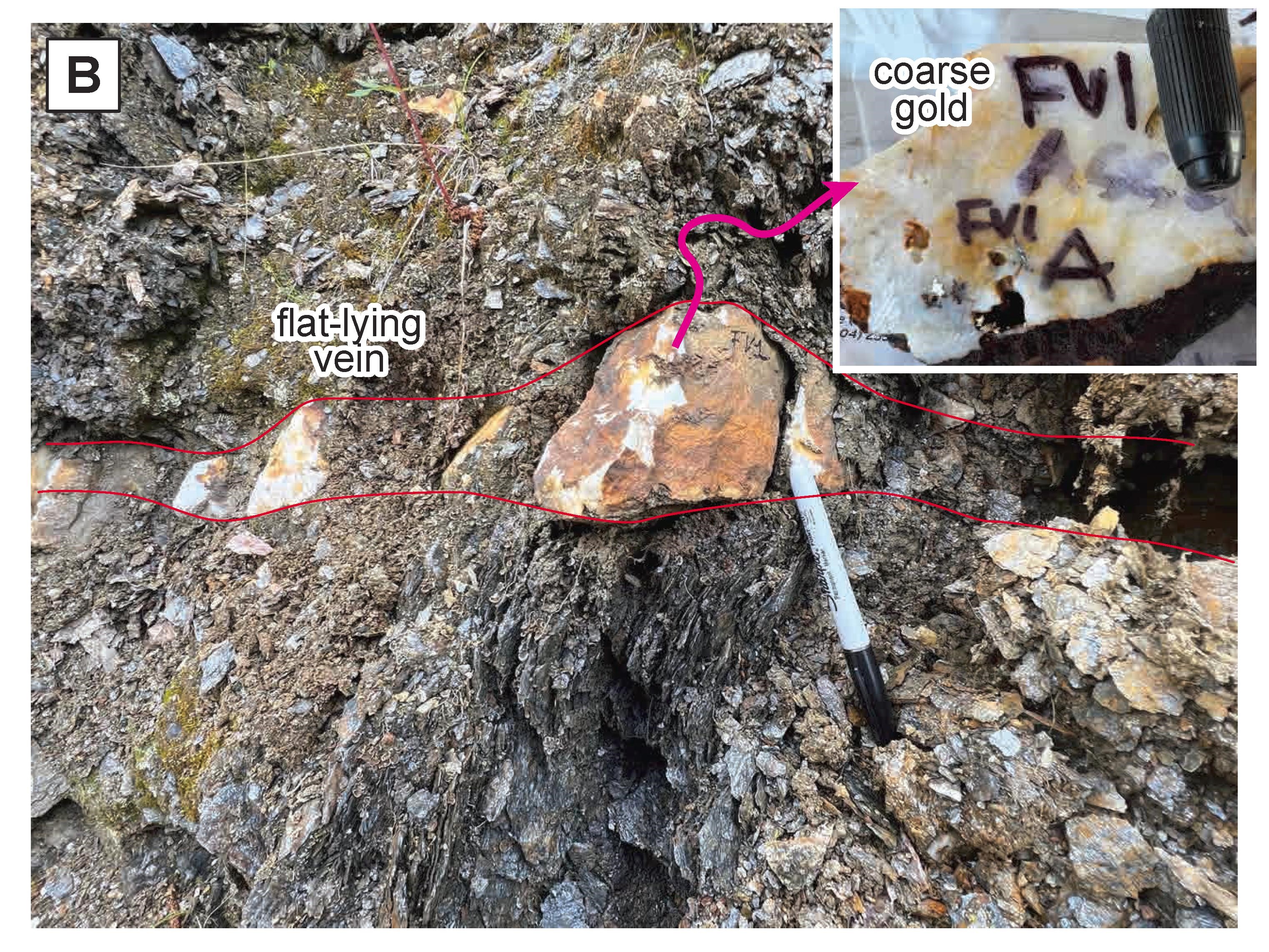Vancouver, British Columbia, Canada – February 21, 2023 – Klondike Gold Corp. (TSX.V: KG; FRA: LBDP; OTCQB: KDKGF) (“Klondike Gold” or the “Company”) is pleased to announce a surface outcrop discovery of high-grade gold-silver in quartz veining at the Gay Gulch Showing on the Klondike District Property (the “Property”) located in the Dawson mining district, Yukon, Canada.
SUMMARY
Peter Tallman, Klondike Gold’s President & CEO, states “Our team has discovered another high grade gold-silver vein, this time at the Gay Gulch Showing. The Company’s new partnerships with respected researchers within Canadian and American institutions has been beneficial. Ongoing analysis of work conducted in 2022 is helping to characterize the style and chemistry of gold mineralization and constrain the timing of gold mineralized fault structures. This will allow the Company to identify priority exploration targets for 2023.”
Assay results have been received for a total of 26 surface rock outcrop and subcrop grab samples collected in 2022 from the Property, including the headline Au-Ag sample from Gay Gulch. A total of 14 surface rock samples were collected from examinations of known mineralized localities at Lone Star Zone, Stander Zone, and ‘other’ structural areas of interest. Sampling from selected outcrop and subcrop yielded gold values of >0.05 ppm to 9.6 g/t Au at Lone Star (4 samples), 11.7 g/t Au at Stander (1 sample), and >0.05 ppm to 0.8 g/t Au from various areas (9 samples). The high Au sample was collected on Eldorado Creek approximately 1 km along a structural trend from Gay Gulch. The high gold assay results are from sheeted quartz veins and are in line with expected values.
Significant new observations and sample results that were obtained from Gay Gulch are discussed here.
At the Gay Gulch Showing a total of 12 rock grab samples from outcrop were assayed. A total of 11 of the 12 samples assayed between >0.05 g/t Au and 8.1 g/t Au, 0.3 ppm and 6.3 ppm Ag, and no detectable Te with the highest Au and Ag sample collected from a sheeted quartz vein in line with expected values.
During field work to collect rock grab samples, hand trenching to expand the Gay Gulch Showing exposure revealed gold-bearing quartz veining at the fault contact between quartz augen schist and graphitic schist units. Dr. Ben Frieman, Colorado School of Mines, photographed the outcrop and provided annotations of the geology in Figure A and Figure B.
An outcropping quartz vein at the fault contact was observed to contain abundant coarse visible gold; rock sample “FV1A” was collected for research and part of this was submitted to the Company’s commercial lab for assay as rock sample 1999552. This one sample, Gay Gulch rock sample 1999552, assayed 4,064 g/t Au with 1,149 g/t Ag with anomalous tellurium (16.1 ppm), bismuth (3.5 ppm), antimony (24.6 ppm), and mercury (15.2 ppm).
Figure A: Field photograph of sulfide and visible gold-bearing, flat-lying vein sets. These are hosted folded sit and appear to originate from a prominent, NE-vergent fault developed in carbonaceous units.
Figure B: Field photograph of the vein displayed in Figure A along with an inset photo of sample 1999552 (FV1A) that contains coarse visible gold.
[Annotated field photos with captions provided by Dr. Ben Frieman, Colorado School of Mines].
Research sample FV1A was imaged and analyzed using a Scanning Electron Microprobe (“SEM”) by Dr. Ben Frieman at the Colorado School of Mines. SEM work confirmed telluride minerals are directly associated with the gold (electrum) mineralization as well as silver sulfosalts, among other unique observations shown. This work for the Company establishes a direct link between high gold (Au), silver (Ag), and tellurium (Te) mineralization associated with cross-cutting fault structures.
In 2014 at the Lone Star Zone, Klondike Gold discovered a quartz breccia vein in a cross-cutting fault, similar to sample 1999552. Three rock grab samples from outcrop of this vein assayed 831 g/t Au to 1,776 g/t Au with 205 g/t Ag to 400 g/t Ag with anomalous Te. The full news release dated January 14, 2015 is HERE.
In 2019 at the Stander Zone, the Company intersected a zone of gold including dendritic (electrum) wires plus coarse gold clots assaying 1009 g/t Au with 1035 g/t Ag and with anomalous Te over 1.0 meter in drill hole EC19-267. This interval may also be structurally similar to rock sample 1999552. The full news release dated August 6, 2019 is HERE.
The discovery of high-grade gold-silver bearing quartz veining within a significant fault in outcrop where structural orientation measurements have been collected, the documentation of telluride and silver sulfosalt minerals, the newly linked chemical association of Au-Ag-Te mineralization to structures significantly bolsters the Company’s exploration model of mineralization.
The Company has reviewed exploration information covering the immediate Lone Star – Stander – Gay Gulch area. Numerous linear Au-Ag-Te soil anomalies potentially resulting from in-situ high gold-silver mineralization coincident with LIDAR lineaments interpreted as potential late faults will be high priority targets for 2023 exploration.
In 2022, Klondike Gold established research partnerships involving students and professors from University of Ottawa, University of Toronto, and Dalhousie University in Canada plus the Colorado School of Mines and Centre for Advanced Subsurface Earth Resource Models (“CASERM”) in the United States. This news release includes preliminary research results from Colorado School of Mines / CASERM. Three posters reporting different aspects of ongoing research will be on display at the Prospectors and Developers Association of Canada (PDAC) convention in Toronto in early March.
UPCOMING EVENTS
Klondike Gold will be participating in the following recent or upcoming events:
PDAC (Toronto, ON) – March 5 to March 8, 2023
PDAC (Toronto, ON) – PDAC-SEG Student Minerals Colloquium: 3 Research Poster Displays
All events are subject to change.
QUALIFIED PERSON
The technical and scientific information contained within this news release has been reviewed and approved by Peter Tallman, P.Geo., President and CEO of Klondike Gold and Qualified Person as defined by NI 43-101 policy. Detailed technical information, specifications, analytical information and procedures can be found on the Company’s website.
ABOUT KLONDIKE GOLD CORP.
Klondike Gold is a Vancouver based gold exploration company advancing its 100%-owned Klondike District Gold Project located at Dawson City, Yukon, one of the top mining jurisdictions in the world. The Klondike District Gold Project targets gold associated with district scale orogenic faults along the 55-kilometer length of the famous Klondike Goldfields placer district. Multi-kilometer gold mineralization has been identified at both the Lone Star Zone and Stander Zone, among other targets. The Company has identified an Initial Mineral Resource of 469,000 Indicated and 112,000 Inferred gold ounces1, a milestone first for the Klondike District. The Company is focused on exploration and development of its 727 square kilometer property accessible by scheduled airline and government-maintained roads located on the outskirts of Dawson City, Yukon, within the Tr’ondëk Hwëch’in First Nation traditional territory.
1 The Initial Mineral Resource Estimate for the Klondike District Property was prepared by Marc Jutras, P.Eng., M.A.Sc., Principal, Ginto Consulting Inc., an independent Qualified Person in accordance with the requirements of NI 43-101. The technical report supporting the Mineral Resource Estimate entitled “NI 43-101 Technical Report on the Klondike District Gold Project, Yukon Territory, Canada” has been filed on SEDAR at www.sedar.com effective November 10, 2022. Refer to news release of December 16, 2022.
ON BEHALF OF KLONDIKE GOLD CORP.
“Peter Tallman”
Peter Tallman,
President and CEO
FOR FURTHER INFORMATION:
Telephone: (604) 609-6138
E-mail: info@klondikegoldcorp.com
Website: www.klondikegoldcorp.com
Neither the TSX Venture Exchange nor its Regulation Services Provider (as that term is defined in the policies of the TSX Venture Exchange) accepts responsibility for the adequacy or accuracy of this release.
Certain statements contained in this news release constitute “forward-looking statements”. When used in this document, the words “anticipated”, “expect”, “estimated”, “forecast”, “planned”, and similar expressions are intended to identify forward-looking statements or information. These statements are based on current expectations of management, however, they are subject to known and unknown risks, uncertainties and other factors that may cause actual results to differ materially from the forward-looking statements in this news release. Readers are cautioned not to place undue reliance on these statements. Klondike Gold does not undertake any obligation to revise or update any forward-looking statements as a result of new information, future events or otherwise after the date hereof, except as required by securities laws.


